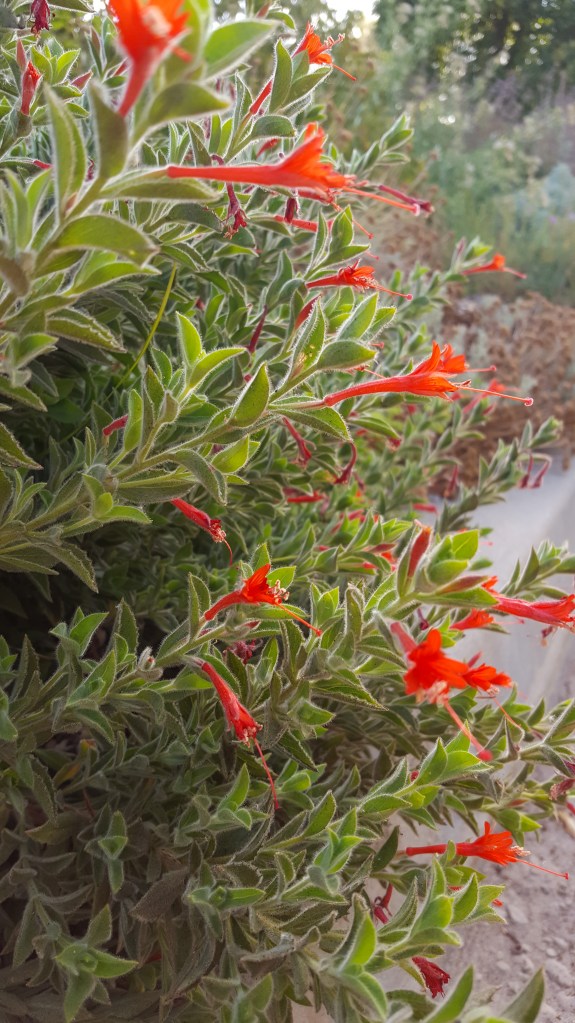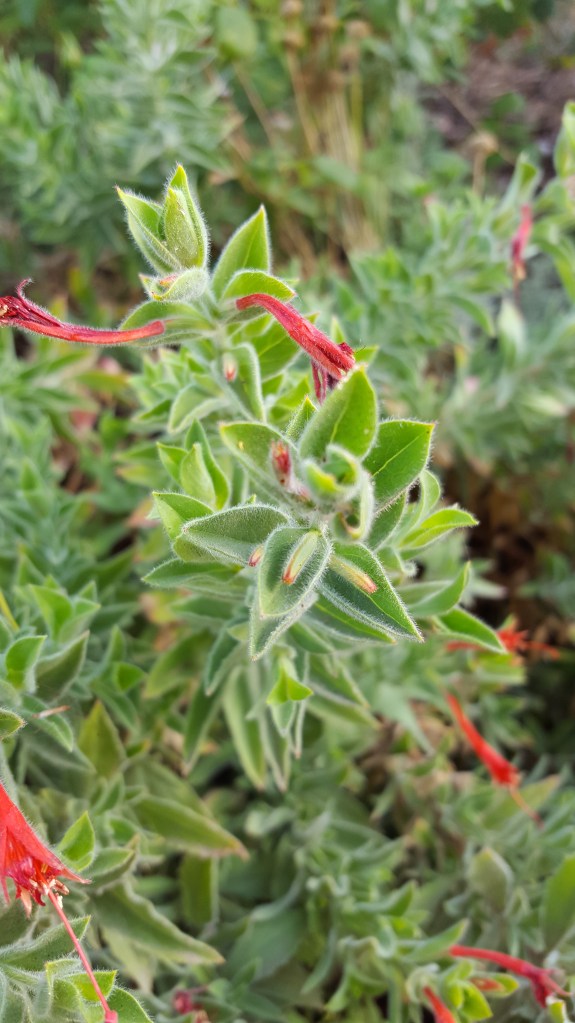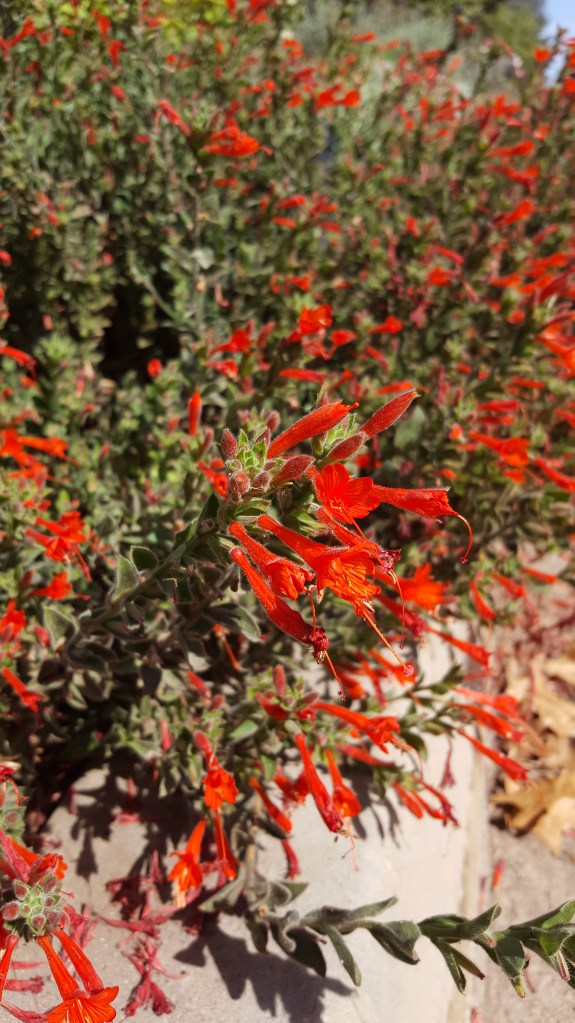
Let’s face it, plants that bloom in spring and summer get the lion’s share of attention in nursery’s and gardens. Soooo… what’s happening in your garden in the fall?

(All links open a new page, so you won’t lose your spot when you look around! Get information on gardening and cultural traditions, recipes, stories, and more!)
A handy growing summary chart is at the end of the article.
When our hot summers finally pass here, the garden often looks a bit ragged. Even for drought and heat tolerant plants, our summers take a toll. We might get a little rebirth of blooms in the fall, but most of our plants have given up for the year. This sets the stage perfectly for the profusion of color that comes from our various California fuchsias.

Despite differences in growth habits and structure, California fuchsias have in common profuse displays of vivid red-orange, tubular flowers held along stems filled with fuzzy leaves of various shades of green to grey-green color. The show begins at the height of summer and continues well into the cooler days of autumn, when there are few plants flowering. The flowers are a natural magnet for bees, bumblebees and hummingbirds.
“Everett’s Choice” is a low growing and slowly spreading variety of California fuchsia. It’s height typically stays below a foot, making it perfect for the front and edges of a flower border. It can spread by several feet helping to shade the soil, fill in open areas, and suppress weeds. It’s spread is slow, though, so it’s easy to keep it limited if desired.
Like other fuchsias, “Everett’s Choice” is very drought and heat tolerant, and is also tolerant of poor soil. In our garden it is in heavy clay with a layer of dense hard pan underneath and shows no indication that it is bothered by it. No critters seem to be able to pester it, and though we don’t have to deal with deer, it is reported to be deer tolerant.

“Everett’s Choice” does want full sun, even when full sun means full heat. Our fuchsia is near a taller rose and the fuchsia halts it’s spread in the zone where the rose casts regular shade. If you have hot spots in your garden that are challenging for plants to tolerate, then this fuchsia would be a good solution. Ours sits at the edge of the curb along the street, which is blazing hot on a 110 F day.
California fuchsias are evergreen and perennial, so even when the plant is not blooming, you’ll still have a unique shade of green to color your garden all year. Many fuchsias have grey-green leaves, but “Everett’s Choice” has more of a yellow hue, which breaks up the monotony of many other plants. You’ll get to enjoy that color year round since it not only tolerates high heat, it can also survive in well below freezing temperatures down to 5 F. It’s as hardy as it is attractive!

Plant Summary:
- Perennial: Plants will live for several years
- Evergreen
- Height: typically no more than 1 foot
- Width: can spread about five feet around
- Sun: full sun, will be scraggly in shade
- Water: very low need, but will want more in very hot conditions
- Soil pH: neutral to slightly acidic
- Soil type: tolerant of poor soils, but sandy soil should be amended to allow for some water retention
- Key nutrients: fertilize as you would for other flowers, though likely not needed
- Planting time: transplant in fall as temperatures drop to allow it to be established before summer
- Zones: 7 and up


In a warm climate, this one seems to do better with a little bit of watering. I do not know how much it needs, and I know it does not need much, but it does not seem to bloom well or maintain good foliar color without any water at all. On the coast, it probably needs no watering, but does not bloom so well without the warmth.
LikeLiked by 1 person
Ours gets watered regularly since we can expect to see no rain at all from May to October, however, it’s not heavy watering. We’ve tried to include as many heat and drought tolerant plants as possible. The location this fuchsia is in definitely packs the heat and I’m impressed by how well it grows despite it!
LikeLiked by 1 person
Your heat is hotter that ours. Well, there is a bit more of it, and it lasts into the nights. It is the watering that would concern me, only because the few of these that I have worked with were in landscapes that did not get watered after the plant material was established. The plants were healthy, just partially dormant as they would be in the wild. That was when I was working for a so-called ‘landscape company’. We typically watered landscapes so much that things rotted in the mud. Then we had ‘native’ landscapes that did not get enough water at all. California fuchsia survived, but would have looked better with occasional watering through summer. It certainly does not ‘need’ much.
LikeLiked by 1 person
Our plants are pretty well clustered by water needs and I’ve learned by a lot of trial and error (sadly, a lot of error!). I have three varieties and so far my issue has been more of containing their spread, especially my Silver Select. That one is very aggressive but thankfully, not too hard to rip out to keep it contained! They’ve all been in the ground for about four or five years now. For sure here they need watering, but not too much. We don’t water like our neighbors who send rivers down the gutter each time (and then they wonder why their lawn looks bad).
LikeLiked by 1 person